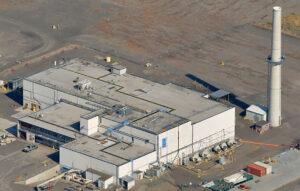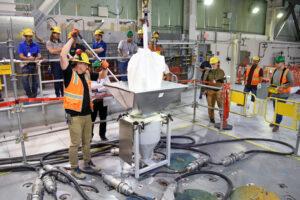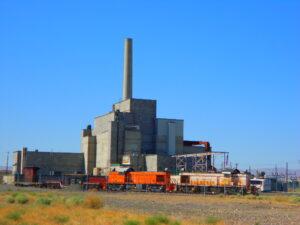This month, we round up the top stories and headlines from the Hanford Site, with updates at the Vit Plant, 324 Building, K Reactor and more.
The following stories cover recent updates at various Hanford Site locations…
 DOE Shifts Gears on its Approach to Remediating Hanford’s 324 Building
DOE Shifts Gears on its Approach to Remediating Hanford’s 324 Building
U.S. DEPARTMENT OF ENERGY
Earlier this year, structural stabilization work at Hanford’s 324 Building was paused after crews discovered a significant amount of additional soil contamination under the building. Further sampling was conducted and validated by scientists at the Pacific Northwest National Laboratory, to assess the extent of contamination.
Recognizing this changed condition, DOE, in coordination with its regulator the U.S. Environmental Protection Agency, is evaluating changes to the cleanup approach that is safer for the workforce, protective of the environment and effective in completing the mission. DOE is considering a resequencing of the work to deactivate the 324 Building, demolish it to slab on grade, construct a containment superstructure over the slab on grade and then remediate the contaminated soils. Any changes to the cleanup approach will follow applicable regulatory processes including, as appropriate, soliciting tribal and public input.
The 324 Building remains in a safe and stable configuration. Contaminated soils beneath the structure have remained stable for decades and existing monitoring indicates no migration of contamination into the groundwater. Crews will continue to monitor groundwater to ensure worker and public safety and health.
While this change in approach will take longer to complete, it represents a safer path to remediation and aligns with current budget profiles through fiscal year 2025.

Molten Glass Fills Vit Plant Melter
HANFORD VIT PLANT
The Vit Plant team last week poured the first batches of glass-forming beads, called frit, into a melter heated to 2,100 degrees Fahrenheit. At that temperature, the beads melted and created the first molten pool inside the melter, which during future hot operations will immobilize radioactive and chemical tank waste in a form safe for permanent disposal.
The accomplishment represents another positive step toward waste treatment operations at the Vit Plant’s Low-Activity Waste (LAW) Facility as part of DOE’s Direct-Feed Low-Activity Waste program at Hanford.
“This is a proud time for our Hanford team as we have established a molten glass pool in our first melter,” said Hanford Site Manager Brian Vance. “It’s a tremendous success made possible through the entire team’s dedication to safely progressing our important cleanup mission.”
Two 300-ton melters inside the LAW Facility are the heart of the vitrification process, which will immobilize the tank waste in glass. During vitrification, treated waste will be fed to the melter and then mixed with glass-forming materials heated to 2,100 degrees Fahrenheit and poured into specially designed stainless-steel containers. The containers will then be moved a short distance to the Integrated Disposal Facility at the Hanford Site for disposal.
 Hanford Demolition Paves Way for Cleanup Progress Near Columbia River
Hanford Demolition Paves Way for Cleanup Progress Near Columbia River
U.S. DEPARTMENT OF ENERGY
RICHLAND, Wash. – A Hanford Site building that was critical to transferring radioactive sludge away from the Columbia River is coming down. Demolition of the K West Reactor Annex is another key step toward completing cleanup at the former plutonium production reactor.
The project includes draining and removing the reactor’s spent-fuel basin where the sludge was stored, then placing the reactor building in interim safe storage.
“The annex building accomplished its mission to support the safe packaging and transfer of sludge from the basin in 2019,” said Mark French, Department of Energy Richland Operations Office division director for Hanford’s Central Plateau Cleanup Project. “Now, removal of the facility allows us to continue the progress we’ve already made to reduce risk in Hanford’s K Area and along the river.”
Crews with contractor Central Plateau Cleanup Company (CPCCo) have been moving and sorting radioactive debris into underwater bins in the 1.2-million-gallon basin since last summer. Workers using underwater cameras and specialized tools place the contaminated material into steel tubes, which will be filled with grout, a concrete-like substance, and removed during basin demolition.
 Historic B Reactor in Eastern WA Shutting Down Tours for 2 Years – Why it’s Closing
Historic B Reactor in Eastern WA Shutting Down Tours for 2 Years – Why it’s Closing
TRI-CITY HERALD
If you’ve been planning to tour Hanford’s historic B Reactor, part of the Manhattan Project National Historical Park, don’t procrastinate. After the current tour season ends Nov. 18, no more tours will be scheduled until at least spring 2026.
Eighty years after construction of the world’s first full-scale reactor began, it’s showing its age.
The Department of Energy will be closing the reactor to the public to replace its roof and make some other repairs and improvements. DOE is sorry that the reactor will need to close during the work, but “parks are forever,” said Colleen French, National Park program manager. “It is so important that we are making the investment now so that we can make sure this place is around for future generations,” she said.
B Reactor was built in less than a year as the Allies raced to develop an atomic bomb before Nazi Germany. The reactor produced the plutonium used to fuel the first detonation of a nuclear weapon, the Trinity Test in New Mexico, as moviegoers are seeing re-enacted in “Oppenheimer.”
B Reactor also produced plutonium for the atomic bomb dropped on Nagasaki, Japan, Aug. 9, 1945, just weeks after the Trinity Test. Japan surrendered Aug. 15, 1945, ending World War II.

